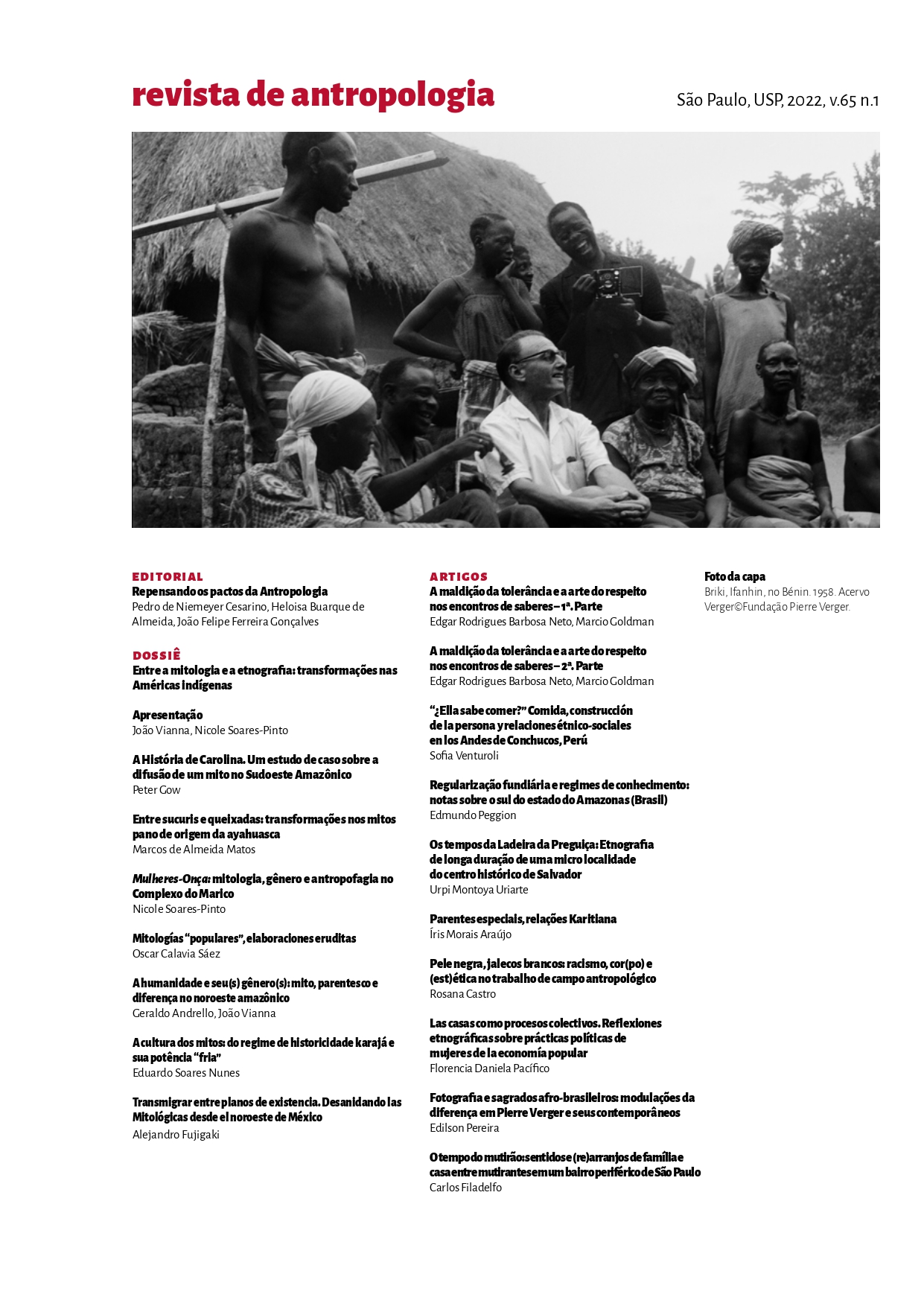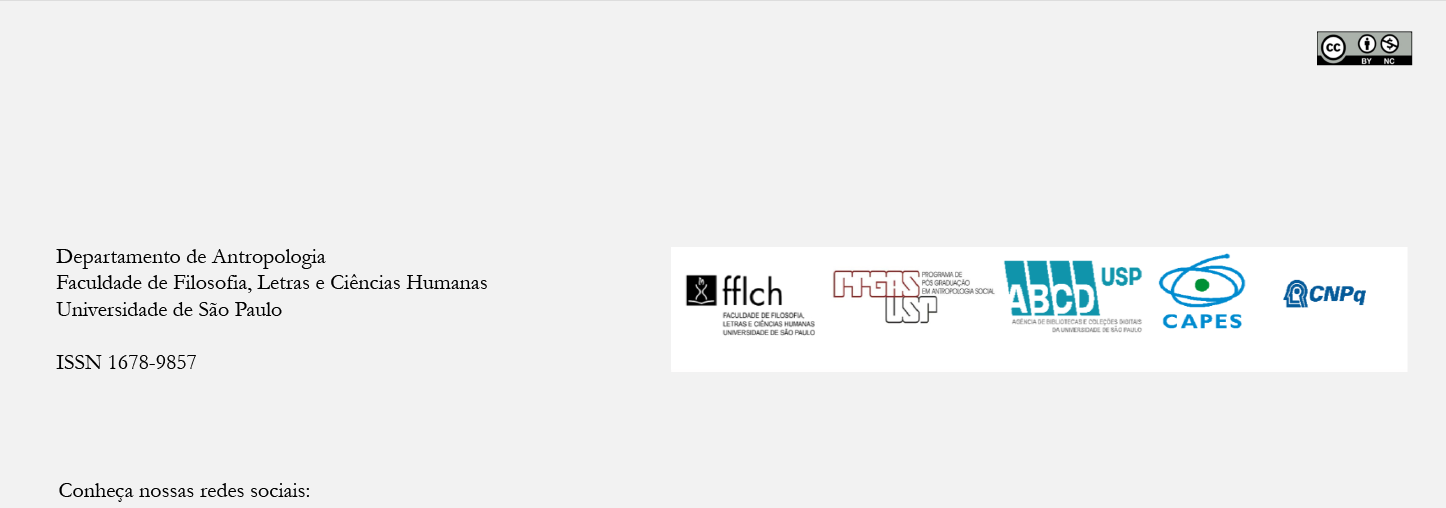Carolina’s Story. A case study of the diffusion of a myth in Southwestern Amazonia
DOI:
https://doi.org/10.11606/1678-9857.ra.2022.192829Keywords:
Ensemble, Mythology, Incest, History, MoonAbstract
Peoples can disappear, but not stories. This is what happened with a kuniba myth, narrated to Nimuendaju by Carolina, in a situation of forced removal promoted by the Brazilian State at the beginning of the 20th century. Such myth was about the origin of the moon, caused by the incest of a brother with a sister. Until the beginning of the 20th century, neighboring peoples of the Kuniba, such as the Cashinahua and the Kanamari, had very different narratives about the origin of the moon. However, throughout the 20th century, with the departure of the Kuniba, the theme of incest between brother and sister becomes part of the narratives, spreading throughout the region of the Juruá and Purus river basins. This leads to a reflection on the problem of “informational causality”, on the “foreign policy” that differentiates peoples, and on the “spatial dialectic” promoted by myths.
Downloads
References
ABREU, João Capistrano de. 1941 Rã-txa hu-ni-ku-i: Grammatica, textos e vocabulário Caxinauás. Edição da Sociedade Capistrano de Abreu.
CARVALHO, Maria Rosario Gonçalves de. 2002 Os Kanamari da Amazônia Ocidental. História, mitologia, ritual e xamanismo. Salvador: Ed. Casa de Palavras.
CHANDLESS, William. 1986 “Notes of a Journey up the River Juruá”. Journal of the Royal Geographical Society of London, Vol. 39: 296-311.
COSTA, Luiz. 2007 As Faces do Jaguar: Parentesco, História e Mitologia entre os Kanamari da Amazônia Ocidental. Tese defendida no Programa de Pós-Graduação em Antropologia Social do Museu Nacional, Rio de Janeiro.
CUNHA, Euclydes da. 1907 Peru versus Bolívia. Rio de Janeiro, Livraria Francisco Alves.
DESHAYES, Patrick; KEIFENHEIM, Barbara. 2003 Pensar el Otro entre los Huni Kuin de la Amazonía Peruana. Trad. Balbina Vallejo. Lima: CAAAP.
LÉVI-STRAUSS, Claude. 1949 [2019] “La politique étrangère d’une societé primitive”. In: Anthropologie Structurale Zéro. Vicent Debaene (ed.). Paris: Éditions du Seuil: 201-219.
LÉVI-STRAUSS, Claude. 1964 [2004] Mitológicas: O Cru e o Cozido. Trad. Beatriz Perrone-Moisés. São Paulo: Cosac & Naify.
LÉVI-STRAUSS, Claude. 1968 [2006] Mitológicas: A origem dos modos à mesa. Trad. Beatriz Perrone-Moisés. São Paulo: Cosac & Naify.
LÉVI-STRAUSS, Claude. 1971 [2011] Mitológicas: O homem nu. Trad. Beatriz Perrone-Moisés. São Paulo: Cosac & Naify.
MCCALLUM, Cecilia. 2001 Gender and Sociality in Amazonia. How real people are made. Oxford: Berg.
MUNN, Nancy. 1973 Walbiri Iconography: Graphic Representation and Cultural Symbolism in a Central Australian Society. Ithaca: Cornell University Press.
NIMUENDAJU, Curt. 1986 “Mitos Indígenas na Obra de Curt Nimuendaju”. Revista do Patrimônio Histórico e Artístico Nacional. n. 21: 64-111.
SASS, Walter (org.). 2007 Tâkuna. Nawa Bûh Amteiyam Amkira. Mitos Kanamari. São Leopoldo: Ed. Oikos & COMIN.
TASTEVIN, Constant; RIVET, Paul. 1923/1924 “Les langues du Purús, du Juruá et des régions limitrophes. Io Le groupe arawak pré-andin (Fin)”. Anthropos, Bd. 18/19, H. 1./3.: 104-113.
VIVEIROS DE CASTRO, Eduardo. 2001 “GUT feelings about Amazonia: potential affinity and the construction of sociality”. In: Laura Rival e Neil Whitehead (eds), Beyond the visible and the material. The Amerindianization of society in the work of Peter Rivière. Oxford: Oxford University Press: 19-43.
VIVEIROS DE CASTRO, Eduardo. 2002 A inconstância da alma selvagem e outros ensaios de antropologia. São Paulo: Cosac & Naify.
Downloads
Published
Issue
Section
License
Copyright (c) 2022 Revista de Antropologia

This work is licensed under a Creative Commons Attribution 4.0 International License.
Authors who intend to publish in this journal must agree with the following terms:
- a) Authors retain copyright and grant the journal the right of first publication. The work is simultaneously licensed under the Creative Commons Attribution License, which allows the work to be shared as long as the author and the initial publication in this journal are appropriately credited.
- b) Authors are authorized to sign additional contracts for non-exclusive distribution of the version of the work published in this journal (e.g., to publish it as a book chapter), as long as the author and the initial publication in this journal are appropriately credited.
- c) Authors are allowed and encouraged to publish and distribute their work online (e.g. on their personal webpage) after the editorial process, for this can generate productive changes as well as increase the impact and citation of the work. See The Effect of Open Access Publications.




